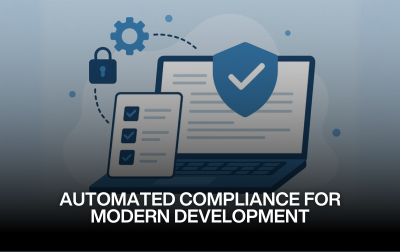
Compliance Automation in Enterprise Software Development
In modern enterprises, regulatory compliance is no longer just a responsibility of legal teams. It has become a foundational part of the software development process. With global regulations increasing in complexity and scope, companies are under pressure to remain compliant—without slowing innovation or scaling efforts.
Compliance automation has emerged as a strategic approach to meet this challenge. It allows businesses to proactively manage regulatory requirements, minimize the risk of violations, and improve efficiency across the development lifecycle.

The Rising Stakes of Compliance in Software Development
Regulatory frameworks like GDPR, HIPAA, NIS2, the Digital Services Act (DSA), and the upcoming Cyber Resilience Act (CRA) demand rigorous standards for data protection, cybersecurity, and operational transparency. Manual compliance efforts simply cannot keep up with the pace and complexity of today’s development environments.
Compliance now influences decisions across:
- Product release timelines
- Cloud infrastructure and deployment models
- Data governance and access control
- Audit documentation and traceability
Embedding compliance automation directly into the development lifecycle ensures that software products are built to meet regulatory requirements from the start—reducing the need for costly retroactive fixes.
Understanding Compliance Automation
Compliance automation involves using software tools and structured processes to monitor, enforce, and document adherence to regulatory requirements throughout the software delivery pipeline.
Key components of compliance automation include:
- Logging system events and user activities automatically
- Enforcing access control policies within code and infrastructure
- Continuously scanning for security misconfigurations
- Generating audit trails and regulatory reports on demand
- Real-time alerts for policy violations or anomalies
This approach replaces manual checklists with consistent, transparent systems that support development and operations teams.

Strategic Benefits for Enterprises
1. Lower Risk Exposure
Automation reduces human error and ensures critical checks are consistently applied across environments—even during fast-paced development.
2. Accelerated Audits
Pre-built reporting and detailed logs allow teams to complete audit processes in a fraction of the time, improving responsiveness and credibility.
3. Operational Efficiency
Routine compliance tasks—such as access documentation or system verification—are handled automatically, reducing time and cost.
4. Stronger Data Security
Real-time monitoring quickly detects unauthorized activity or misconfigurations, improving the organization’s security posture.

Real-World Applications
- Financial Services: Maintaining SOC 2, ISO 27001, and SEC compliance for data transparency and risk management
- Healthcare: Protecting patient data under HIPAA across mobile and cloud-based systems
- Tech Providers: Adhering to EU directives (GDPR, CRA, NIS2) when delivering enterprise-grade software
- High-Growth Startups: Scaling securely while entering regulated markets

Building Blocks of Compliance Automation
Compliance automation is an ecosystem rather than a single tool. Successful implementation spans multiple teams and disciplines.
Policy-as-Code
Express compliance rules in machine-readable formats (e.g., YAML or JSON) and enforce them automatically with tools like Open Policy Agent (OPA).
Centralized Logging
Track actions across systems, applications, and infrastructure using platforms like HashiCorp Vault, AWS CloudTrail, or Elastic SIEM.
Automated Reporting
Deliver up-to-date compliance documentation using solutions such as Drata, Vanta, or OneTrust—useful for both internal reviews and third-party audits.
Continuous Compliance Monitoring
Use scanning and alerting systems to detect violations and remediate them immediately, reducing time-to-resolution and exposure.

Choosing the Right Technology Partner
Implementing compliance automation effectively requires specialized expertise. When evaluating a tech partner, look for:
- Experience in regulated sectors such as finance, healthcare, or SaaS
- Proficiency in DevSecOps practices and CI/CD pipelines
- Up-to-date knowledge of relevant regulations in your target markets
- Proven internal processes that include logging, auditing, and access control
A Technology Partnership model, like the one Aleron IT offers, helps integrate compliance considerations directly into the software architecture—creating systems that are scalable, secure, and regulation-ready.
The Competitive Edge of Automated Compliance
Compliance doesn’t have to be a barrier. With the right approach, it becomes a strategic advantage. Enterprises that automate their compliance processes can reduce legal risks, respond to audits with confidence, and build lasting trust with clients and regulators.
Need support building compliant software systems? Contact us today to learn how our senior engineering teams can help design, implement, and scale compliance automation solutions tailored to your organization.



